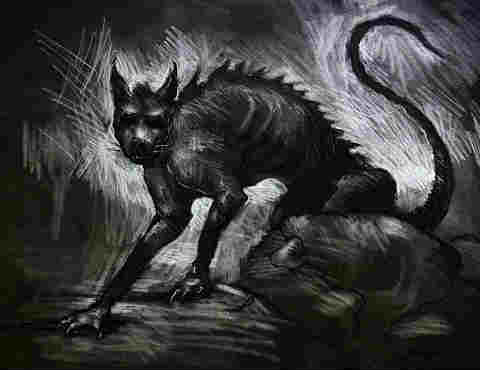Today I'm continuing my series of posts about monsters. While some can be found in nearly all cultures, such as the vampire, others are more regionally specific. Growing up in southern Arizona, I've heard the tale of the Chupacabra very often - but I know some friends from northern states and other countries have not. With that in mind, let's dive into the lore of this goat-sucking terror!
The name Chupacabra translates to "goat sucker". This strange etymology stems from the fact that most stories about el Chupacabra involve dead livestock, drained of their blood. While cattle, sheep, and all manner of livestock and domesticated animals have been reported as victims of the Chupacabra, goats were the most prevalent during its first appearances. Strange puncture marks to the neck, coupled with the complete absence of blood in the dead animal, led to the name "el Chupacabra": the goat sucker.
El Chupacabra has been sighted in numerous parts of the world, but is predominantly found in Latin America and the far south of the United States. Its first sightings were in Puerto Rico in March of 1995. (Given that I was born in March of '95, the Chupacabra holds a special place in my heart.) Reports soon spread across Latin America, from countries including Brazil, Nicaragua, Mexico, and Chile. In each case, animals had been found drained of their blood - and sometimes, a strange creature had been sighted near them.
So just what does a Chupacabra look like? This is where it gets really interesting. El Chupacabra has been described in two drastically different forms. The first, beginning in 1995, is considerably more reptilian in appearance. Think of it as sort of a scaly kangaroo, bipedal, a sickly green in colour, with long spines protruding from its back. Sounds pretty scary, right?
Though this description was popular for some time, another soon overtook it. The second version of the Chupacabra is described as more dog-like in appearance. This creature's skin is taut against its bones, leading to pronounced eye sockets and a prominent spine ridge. Terrifying teeth and claws complete the horrific visage.
How did two appearances so different from on another come to be used for the same creature? Well, zoologists have been researching el Chupacabra for years, and believe that they have the answer.
The second description of the Chupacabra, its canine form, has actually been documented through photos and videos. Numerous corpses of the Chupacabra have been found and inspected by scientists. Their conclusion? El Chupacabra is usually a canine of some sort, dog, coyote, or wolf, which has been infected with mange. In animals mange will cause hair loss and itchiness. A canine afflicted by this disease would tear its own skin trying to scratch the itch away, and would look like some sort of otherworldly monster without its fur. Hunger, brought on by weakness caused by the disease, could lead to an emaciated appearance - which would account for the pronounced bone ridges.
(A dog afflicted with mange.)
But what of the first description of el Chupacabra, the scaly monster with a spiky back? For that answer, investigators have turned to science fiction.
A movie called Species was released in 1995. One of its primary characters was an alien played by Natasha Henstridge, whose design was created by the same man who designed the Alien xenomorphs. Its appearance? A scaly green-grey creature with spine-like appendages protruding from her back.
Parts of Species were filmed in Puerto Rico, where the first report of a Chupacabra originated. The woman who first described el Chupacabra even admitted in her description that it looked similar to the monster from Species.
However, there is a flaw in this theory. The first report occurred in March of '95 - but Species did not release until July of that year. Could the woman have seen previews or stills of the creature in the movie, colouring her description? Or does el Chupacabra truly exist, and merely bear an eerie resemblance to the fictional monster?
Chupacabra sightings continue to this day, and have spread past Latin America to other parts of the world. The Philippines have a similar creature in their legends, and Russia has reported Chupacabra appearances. Though numerous attempts have been made to disprove the creature's existence, el Chupacabra's legend continues to grow.
I'll see you guys next week!





cool dude thanks
ReplyDelete